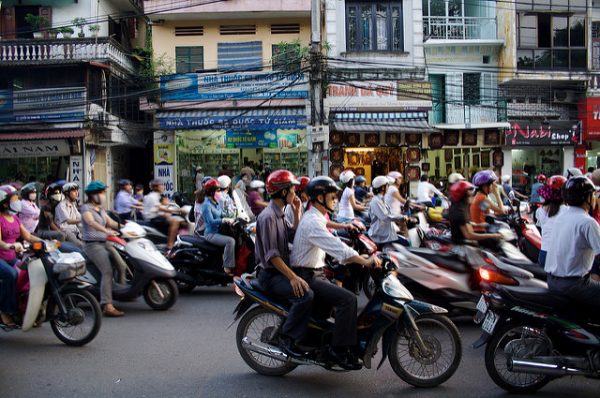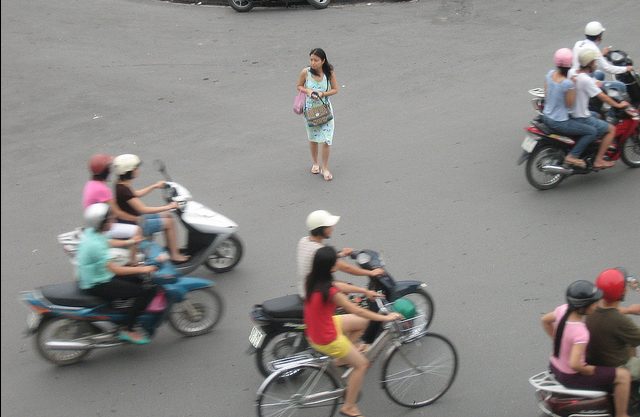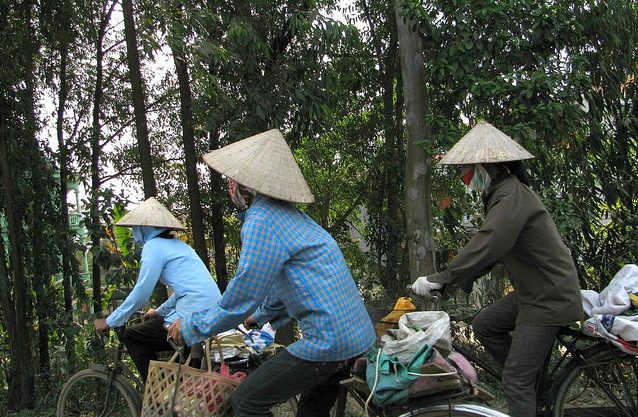

The Trick to Cross the Street
My heart pounded. I struggled for the courage to cross the street like a local. Stepping from the curb, I focused on the opposite side and walked and prayed and kept walking, waiting to hear the crunch of metal meeting bone.
The trick, I realized, was to never look both ways, despite that childhood advice my mother had pounded into me.
The sight of oncoming traffic coming full throttle mushroomed into fear, but I knew that if I wanted to explore, I needed to wear a good luck charm, hang on to it and just go.
Chickens would never make it here.
What My Travel Brochure Said
The travel brochure I had picked up at Hanoi’s Noi Bai Airport scared the hell out of me. It identified in bold print the number one tip for surviving Vietnamese cities―How to Cross the Street and Live to Tell about It. It read:
INSTRUCTIONS for CROSSING the ROAD: Step from the curb, walk slowly and deliberately at a steady pace. Never stop moving.
Never retreat. Make no jerky movements. Don’t run. Raise your hand lower than your shoulder to signal that you are advancing.
The airport cab had zipped us along to Hanoi, Vietnam’s ancient capital.
Bucolic scenes in adjacent fields unfolded as cone-shaped hats atop Asian pajamas bobbed up and down in a sea of green rice stalks, while trusted water buffalo waited for duty.
What’s the problem with crossing the street? This looks easy, I thought. But, as we neared the city’s fringe, the serenity vanished, replaced by reality.
The Nightmare
A nightmare of swarming vehicles, motorbikes, scooters, motorcycles, two-wheeled contraptions of every cc and size emerged from everywhere.
Some even traveled opposite to the flow, all avoiding obstacles in constant near-miss collisions with the minority four-wheeled, metal conveyances.
The mayhem didn’t faze our driver, but the staggering buzz of motor-bees triggered my ‘chicken’ instincts. I pulled out those instructions to reread them before the test.

A 125cc Honda, carrying a family of four, hugging each other tightly, flip-flops dangling from their feet. It overtook the taxi and darted directly across its path.
Brakes squealed. My whitened knuckles pressed into the armrest. At this point, crossing the street seemed irrelevant; making it to the hotel alive took precedence.
Motorbikes ruled the road. Traffic regulations didn’t exist or went ignored. Welcome to Vietnam.
The taxi veered onto a narrow street in Hanoi’s Old Quarter. The mental impact of thousands of motorbikes coming straight at us seared an image like the imprint of a branding iron.
Men, women, teenagers, business suits, high heels, and funky outfits made up this ‘motor madness.’ Covered from head to toe, only the riders’ eyes peered out above cloth face masks and under newly required helmets, which they call ‘rice-cookers.’
I asked the driver why the riders had every inch of body concealed.
“To protect from the sun; they think, the whiter their skin, the better,” he said.
On the frenzied route to the hotel, I saw no traffic lights. No stop and go, no slowing, just bikes carrying people and cargo.
Discovering Vietnam
Innovative Vietnamese have turned these cheap, easily maintained modes of transportation into delivery vans, mobile businesses or open-air taxis.
My concentration on the traffic chaos shifted to the assortment of loads that whizzed by.

One bike had 30 bird cages, each with its own live bird, in a six-foot high tower that encased the driver, leaving only his face and arms visible.
A woman weaved about with a washing machine strapped to her seat; a young girl, sandwiched between a huge computer box in front of her and a desk, chair and shelves secured to the rear, maneuvered through the maze.
A mobile fish market with live fish sloshing about in plastic containers fastened to a scooter, sped by.
Vietnam has an estimated population of 89 million and 37 million registered motorbikes. Elders, using rusty, worn-out bicycles must share precious road space with the motorized ones.
Just then, a moped crashed into an old woman peddling her overloaded pushbike, sending her and mounds of radishes to the street. No one helped to upright her transport and wares. There is no stopping.
After reaching the hotel unscathed, the decision loomed. Would I have the courage to see Hanoi, or would I remain paralyzed on the sidewalk?
The number of motorbikes had tripled for a Saturday night of bike cruising in Hanoi. It would take three street crossings to reach the restaurant. ‘Chicken queasiness’ stirred. The city sizzled, its excitement brewed contagion.
Smells of crayfish hissing in garlic, herbed oil, slick night-market vendors offering knock-offs, and the zoom-zoom of Scooterville electrified me to ‘take the road test.’
I closed my eyes and went. It’s the only way. Locals told me that the bikes would anticipate my moves. I had to trust that or fail.

After that first frightful scurry, I pretended to be blind for street-crossing; in Hanoi, Hue, Hoi An, DaNang and the grand prix of all motorbike cities, crazy Saigon, Ho Chi Minh City.
Here five million bikers turn wide boulevards into chasms of fear. Riders drive on the sidewalks, through the central market and straight into shops. Here, chickens become breakfast ― Vietnamese Pho Bo soup.
Author’s Bio: After a life-long profession of treating the mentally ill at a PA psychiatric hospital for 33 years and also serving as its Director of Admissions, Carol retired to Lake Chapala, Mexico in 2006 with her husband, to pursue more positive passions. Her family thought that she, too, had ‘gone mad.’ She’s been teaching English to Mexican adults for ten years, in a program operated by volunteer expatriates and writing for local on-line and print publications. Using her adventures experienced during visits to over 80 countries to capture a niche in travel writing, Carol also dabbles in ‘memoir.’ A frequent contributor to Lake Chapala English magazine, “El Ojo del Lago,” she’s won several literary awards from that publication, including Best Feature in 2010 and Best Fiction in 2014. She also netted a story regarding her psychiatric field work in the published anthology, “Tales from the Couch.”
[mappress mapid=”987″]
- How to Get Around in Sydney: A Local’s Guide to Traveling Around Sydney - April 24, 2024
- The Low-Key Magic of Ghent, Belgium - April 22, 2024
- Discover the Hidden Charm of Extremadura in Spain - April 20, 2024
